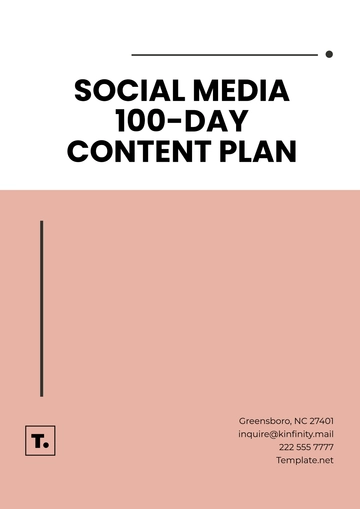Free Social Media Sales Plan

I. Introduction
In today's digital landscape, social media platforms serve as powerful tools for driving immediate sales and engaging with potential customers. This Social Media Sales Plan aims to outline strategies for running targeted promotions and sales campaigns to boost sales effectively.
II. Goals and Objectives
Increase sales revenue by [X%] within [TIMEFRAME].
Generate [X] number of leads through social media channels.
Improve brand awareness and engagement on social media platforms.
Drive traffic to the company's website and online store.
III. Target Audience Analysis
Identify and analyze the target audience based on demographics, interests, behaviours, and preferences. Understanding the audience will help tailor promotional content and campaigns for maximum effectiveness.
IV. Platform Selection
Select social media platforms based on where the target audience is most active. Focus efforts on platforms such as:
Facebook
Instagram
Twitter
LinkedIn
TikTok (if relevant)
V. Content Strategy
Develop a content strategy that aligns with the sales objectives and resonates with the target audience. Content types may include:
Promotional posts showcasing products/services.
User-generated content (UGC) to encourage engagement.
Educational content related to products/services.
Behind-the-scenes content to humanize the brand.
VI. Promotion and Campaign Strategy
Outline specific promotions and sales campaigns designed to drive immediate sales. Strategies may include:
Limited-time offers and discounts.
Flash sales and exclusive deals for social media followers.
Social media contests and giveaways to incentivize engagement.
Influencer partnerships to reach a wider audience.
VII. Content Calendar
Create a content calendar to schedule posts and campaigns in advance. Ensure consistency in posting frequency and timing to maintain audience engagement.
[PROVIDE A SAMPLE CONTENT CALENDAR WITH SCHEDULED POSTS, CAMPAIGNS, AND PUBLISHING DATES].
VIII. Monitoring and Measurement
Implement tools and metrics to monitor the success of social media efforts. Key performance indicators (KPIs) may include:
Sales revenue generated from social media channels.
Engagement metrics such as likes, comments, shares, and clicks.
Conversion rates for promotional campaigns.
Growth in social media followers and audience reach.
IX. Budget Allocation
Allocate budget resources effectively across paid advertising, content creation, and campaign execution. Continuously evaluate ROI to optimize budget allocation for future campaigns.
Budget Category | Allocation ($) |
|---|---|
Paid Advertising | [ENTER AMOUNT] |
Content Creation | [ENTER AMOUNT] |
Campaign Execution | [ENTER AMOUNT] |
Miscellaneous Expenses | [ENTER AMOUNT] |
Total Budget | [TOTAL AMOUNT] |
X. Conclusion
In conclusion, this Social Media Sales Plan provides a comprehensive framework for running targeted promotions and sales campaigns to drive immediate sales. By leveraging the power of social media platforms and implementing strategic tactics, the company can achieve its sales objectives and foster stronger connections with its audience.
- 100% Customizable, free editor
- Access 1 Million+ Templates, photo’s & graphics
- Download or share as a template
- Click and replace photos, graphics, text, backgrounds
- Resize, crop, AI write & more
- Access advanced editor
Boost your sales strategy with Template.net's Social Media Sales Plan Template. Fully customizable and editable, it allows you to tailor your plan effortlessly. Editable in our Ai Editor Tool, ensuring a seamless experience to meet your business needs. Achieve your sales goals with precision and ease.
You may also like
- Finance Plan
- Construction Plan
- Sales Plan
- Development Plan
- Career Plan
- Budget Plan
- HR Plan
- Education Plan
- Transition Plan
- Work Plan
- Training Plan
- Communication Plan
- Operation Plan
- Health And Safety Plan
- Strategy Plan
- Professional Development Plan
- Advertising Plan
- Risk Management Plan
- Restaurant Plan
- School Plan
- Nursing Home Patient Care Plan
- Nursing Care Plan
- Plan Event
- Startup Plan
- Social Media Plan
- Staffing Plan
- Annual Plan
- Content Plan
- Payment Plan
- Implementation Plan
- Hotel Plan
- Workout Plan
- Accounting Plan
- Campaign Plan
- Essay Plan
- 30 60 90 Day Plan
- Research Plan
- Recruitment Plan
- 90 Day Plan
- Quarterly Plan
- Emergency Plan
- 5 Year Plan
- Gym Plan
- Personal Plan
- IT and Software Plan
- Treatment Plan
- Real Estate Plan
- Law Firm Plan
- Healthcare Plan
- Improvement Plan
- Media Plan
- 5 Year Business Plan
- Learning Plan
- Marketing Campaign Plan
- Travel Agency Plan
- Cleaning Services Plan
- Interior Design Plan
- Performance Plan
- PR Plan
- Birth Plan
- Life Plan
- SEO Plan
- Disaster Recovery Plan
- Continuity Plan
- Launch Plan
- Legal Plan
- Behavior Plan
- Performance Improvement Plan
- Salon Plan
- Security Plan
- Security Management Plan
- Employee Development Plan
- Quality Plan
- Service Improvement Plan
- Growth Plan
- Incident Response Plan
- Basketball Plan
- Emergency Action Plan
- Product Launch Plan
- Spa Plan
- Employee Training Plan
- Data Analysis Plan
- Employee Action Plan
- Territory Plan
- Audit Plan
- Classroom Plan
- Activity Plan
- Parenting Plan
- Care Plan
- Project Execution Plan
- Exercise Plan
- Internship Plan
- Software Development Plan
- Continuous Improvement Plan
- Leave Plan
- 90 Day Sales Plan
- Advertising Agency Plan
- Employee Transition Plan
- Smart Action Plan
- Workplace Safety Plan
- Behavior Change Plan
- Contingency Plan
- Continuity of Operations Plan
- Health Plan
- Quality Control Plan
- Self Plan
- Sports Development Plan
- Change Management Plan
- Ecommerce Plan
- Personal Financial Plan
- Process Improvement Plan
- 30-60-90 Day Sales Plan
- Crisis Management Plan
- Engagement Plan
- Execution Plan
- Pandemic Plan
- Quality Assurance Plan
- Service Continuity Plan
- Agile Project Plan
- Fundraising Plan
- Job Transition Plan
- Asset Maintenance Plan
- Maintenance Plan
- Software Test Plan
- Staff Training and Development Plan
- 3 Year Plan
- Brand Activation Plan
- Release Plan
- Resource Plan
- Risk Mitigation Plan
- Teacher Plan
- 30 60 90 Day Plan for New Manager
- Food Safety Plan
- Food Truck Plan
- Hiring Plan
- Quality Management Plan
- Wellness Plan
- Behavior Intervention Plan
- Bonus Plan
- Investment Plan
- Maternity Leave Plan
- Pandemic Response Plan
- Succession Planning
- Coaching Plan
- Configuration Management Plan
- Remote Work Plan
- Self Care Plan
- Teaching Plan
- 100-Day Plan
- HACCP Plan
- Student Plan
- Sustainability Plan
- 30 60 90 Day Plan for Interview
- Access Plan
- Site Specific Safety Plan





























